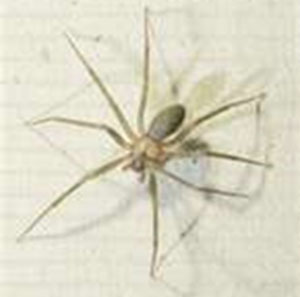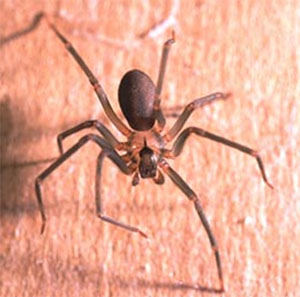Environmental Science Section - Insect and Wildlife
Brown Recluse Spider
The brown recluse belongs to a group of spiders that is officially known as the "recluse spiders" in the genus Loxosceles (pronounced lox-sos-a-leez). These spiders are also commonly referred to as "fiddleback" spiders or "violin" spiders because of the violin-shaped marking on the top surface of the cephalothorax (fused head and thorax). However, this feature can be very faint depending on the species of recluse spider, particularly those in the southwestern U.S., or how recently the spider has molted.
The common name, brown recluse spider, pertains to only one species, Loxosceles reclusa. The name refers to its color and habits. It is a reclusive creature that seeks and prefers seclusion. Brown recluse spiders generally occupy dark, undisturbed sites, and they can occur indoors or outdoors. In favorable habitats, their populations are usually dense. They thrive in human-altered environments. Indoors, they may be found in attics, basements, crawl spaces, cellars, closets, and ductwork or registers. They may seek shelter in storage boxes, shoes, clothing, folded linens, and behind furniture. They also may be found in outbuildings such as barns, storage sheds, and garages. Outdoors, brown recluse spiders may be found underneath logs, loose stones in rock piles, and stacks of lumber.
The brown recluse spider is not aggressive, and it normally bites only when crushed, handled or disturbed. Some people have been bitten in bed after inadvertently rolling over onto the spider. Others have been bitten after accidentally touching the spider when cleaning storage areas. Some bites occur when people put on seldom used clothing or shoes inhabited by a brown recluse.
The physical reaction to a brown recluse spider bite depends on the amount of venom injected and an individual's sensitivity to it. Some people are unaffected by a bite, whereas others experience immediate or delayed effects as the venom kills the tissues (necrosis) at the site of the bite. Many brown recluse bites cause just a little red mark that heals without event. The vast majority of brown recluse bites heal without severe scarring. Initially, the bite may feel like a pinprick or go unnoticed. Some may not be aware of the bite for 2 to 8 hours. Others feel a stinging sensation followed by intense pain. The lesion from a brown recluse spider bite is a dry, blue-gray or blue-white, irregular sinking patch with ragged edges and surrounding redness--termed the "red, white, and blue sign." The lesion usually is 1½ inches by 2¾ inches or smaller.
The bite of the brown recluse spider can result in a painful, deep wound that takes a long time to heal. Fatalities are extremely rare, but bites are most dangerous to young children, the elderly, and those in poor physical condition. When there is a severe reaction to the bite, the site can erupt into a "volcano lesion" (a hole in the flesh due to damaged, gangrenous tissue). The open wound may range from the size of an adult's thumbnail to the span of a hand. The dead tissue gradually sloughs away, exposing underlying tissues. The sunken, ulcerating sore may heal slowly up to 6 to 8 weeks. Full recovery may take several months and scarring may remain.
It is difficult for a physician to accurately diagnose a "brown recluse bite" based simply on wound characteristics. It is absolutely necessary to have the spider for a positive identification. Necrotic wounds can result from a variety of agents such as bacteria (Staphylococcus, "flesh-eating" Streptococcus, etc.), viruses, fungi, and arthropods (non-recluse spiders, centipedes, mites, ticks, wasps, bedbugs, kissing bugs, biting flies, etc.). Necrotic conditions also can be caused by vascular and lymphatic disorders, drug reactions, underlying diseases states, and a variety of other agents.
If bitten, remain calm, and immediately seek medical attention (contact your physician, hospital and/or poison control center). Apply an ice pack directly to the bite area to relieve swelling and pain. Collect the spider (even a mangled specimen has diagnostic value), if possible, for positive identification by a spider expert. A plastic bag, small jar, or pill vial is useful and no preservative is necessary, but rubbing alcohol helps to preserve the spider.
If bitten, remain calm, and immediately seek medical attention (contact your physician, hospital and/or poison control center). Apply an ice pack directly to the bite area to relieve swelling and pain. Collect the spider (even a mangled specimen has diagnostic value), if possible, for positive identification by a spider expert. A plastic bag, small jar, or pill vial is useful and no preservative is necessary, but rubbing alcohol helps to preserve the spider.


SPIDER CONTROL AROUND THE HOME
Preventing spider bites
- Shake out clothing and shoes before getting dressed.
- Inspect bedding and towels before use.
- Wear gloves when handling firewood, lumber, and rocks (be sure to inspect the gloves for spiders before putting them on).
- Remove bedskirts and storage boxes from underneath beds. Move the bed away from the wall.
- Exercise care when handling cardboard boxes (recluse spiders often are found in the space under folded cardboard flaps).
Exclusion
- Install tight-fitting screens on windows and doors; also install door sweeps.
- Seal or caulk cracks and crevices where spiders can enter the house.
- Install yellow or sodium vapor light bulbs outdoors since these attract fewer insects for spiders to feed upon.
- Tape the edges of cardboard boxes to prevent spider entry.
- Use plastic bags (sealed) to store loose items in the garage, basement, and attic.
Sanitation
- Remove trash, old boxes, old clothing, wood piles, rock piles, and other unwanted items.
- Eliminate clutter in closets, basements, attics, garages, and outbuildings.
- Do not stack wood against the house.
- Clean up dead insects that the brown recluse spider can feed on.
Non-chemical control
- Use sticky traps or glueboards to capture spiders.
- Dust and vacuum thoroughly to remove spiders, webs, and egg sacs (dispose of the vacuum bag in a container outdoors).
- Use a rolled up newspaper or fly swatter to kill individual spiders.
Insecticides
There are many labeled pesticides for spider control. Some are labeled for homeowner use, while others are labeled only for the licensed, certified pesticide applicator. It would be prudent to enlist the services of a professional pest management company when dealing with an indoor infestation of the brown recluse spider.
Research indicates that recently developed pyrethroids (e.g., cyfluthrin, cypermethrin, etc.) are particularly effective against brown recluse spiders. Wettable powders and microencapsuled "slow-release" formulations of these chemicals provide residual activity and are preferable to using emulsion-type sprays. Insecticide treatments should be applied so that the chemical contacts as many spiders and webs as possible. Residual liquid sprays should be applied to the outside perimeter of the home (including under eaves, patios, and decks; behind window shutters), baseboards, undisturbed corners, and other suspected spider harborages. Residual dusts should be applied to voids and inaccessible areas where spiders may hide. Aerosol flushing agents such as pyrethrins, though ineffective by themselves in providing control, can cause spiders to move about so that they contact treated surfaces.